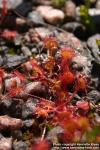Drosera.—Sundew.

 The herb Drosera rotundifolia, Linné.
The herb Drosera rotundifolia, Linné.
Nat. Ord.—Droseraceae.
COMMON NAMES: Sundew, Round-leaved sundew.
Botanical Source.—Sundew is a low, small, perennial, herbaceous, aquatic plant, also called Round-leaved sundew, with a fibrous root, from which arises the leaves, which are radical, small, and nearly round, depressed, lying flat upon the ground, and abruptly narrowed into the spreading hairy petioles. The scapes are erect, 5 to 8 inches high, at first coiled inward, and bearing a simple raceme. The flowers are arranged on one side, very small and white; the sepals are 5, united at the base, and persistent; the petals 5 and convolute. The stamens 5; anthers adnate; styles 3 or 5, each deeply 2-parted. Ovary single. Capsule 3 or 5-valved and many-seeded. The seed's are spindle-shaped, and the coat loose and chaff-like (W.—G.).
History.—Sundew (Ros Solis) is a peculiar little plant, growing in Europe and this country, in bogs, and muddy shores of ponds and rivers, and flowering in July and August. It may be at once distinguished by the reddish glandular hairs with which the leaves are beset, and which are usually tipped with a small drop of a clammy fluid, appearing like a dew drop, glistening in the sun, this secretion being most abundant when the sun is at its highest, from which circumstance it derives its name. The long, shining red hairs of this plant form beautiful objects for the microscope, under which they are seen to consist of an immense number of minute cells, regularly arranged, and exhibiting a most gorgeous variety of brilliant colors. They are very irritable, slowly curved inward, and entrap insects within their reach; the fluid secreted from their points also retains insects which settle upon it. The flowers only open in sunshine. The juice of the plant is bitter, acrid and caustic. The medicinal preparation is the tincture of the recent plant.
Chemical Composition.—Trommsdorf examined the juice of this plant (Chem. Centralbl., 1833), finding in it a free organic acid, probably malic acid, organic salts, and a red coloring principle, which formed an insoluble compound with acetate of lead. Reess and Will believed the free acid to be a mixture of formic, propionic and butyric acids, and Hager thought it to be malic and citric acids combined. Lugan obtained from the juice of the plant a crystallizable acid insoluble in chloroform; besides, a greenish-brown resin, by successive treatment with ether and chloroform. It is soluble in both these solvents and possesses acrid properties. According to Stein's experiments (Ber. d. Deutsch. Chem. Ges., 1879; also Amer. Jour. Pharm., 1880, p. 12), the free acid in Drosera intermedia was identified with citric acid, which acid probably occurs in all species of Drosera. A ferment also seems to be present, capable of converting albuminous substances into peptones. Experiments of H. Büsgen (see Amer. Jour. Pharm., 1885, p. 106) would demonstrate that the plants of drosera are capable of assimilating animal food.
Action, Medical Uses, and Dosage.—This agent appears to exert a peculiar action upon the respiratory apparatus, and its effects are best observed from the use of small doses. It is peculiarly adapted to dry, spasmodic, or explosive coughs, such as are met with in many cases of whooping-cough and measles—for the cough of the latter it being an almost absolute specific. The coughs met by drosera are those in which dryness of the air passages is marked, and there is irritation or even inflammation, and nervous irritation, particularly irritation of the base of the brain and of the parts supplied by the vagus. The special seat of most of the trouble seems to be centered in the larynx. Tickling in that organ, giving rise to spasmodic cough, is met by it, and while exceedingly useful in all coughs having the above characteristics, it appears to benefit best those cases associated with or following measles and whooping-cough. For the latter it may also be given as a prophylactic, and if the individual does contract the disease, the influence of the medicine will have been early obtained. Sanguinarine nitrate acts well with it in dry, tickling cough. It has been found essentially useful in asthma, incipient phthisis, chronic bronchitis, with dry, spasmodic cough, and nervous or sympathetic cough, whether from pulmonary, cardiac, or gastric disease. Two fluid drachms of the saturated tincture, or 1 drachm of specific drosera, may be added to 4 fluid ounces of water (or wine, if indicated), of which a teaspoonful may be administered every 3 or 4 hours. In former times it was considered a powerful aphrodisiac, and as a remedy to cure intermittents, insanity, and to promote delivery. The juice of the plant has been used as a local application for the cure of corns and warts. Dose, of the saturated tincture, 1 to 6 drops; specific drosera to 5 drops.
Specific Indications and Uses.—Expulsive or explosive, spasmodic cough, with dryness of the air passages; whooping-cough; cough of measles; uncontrollable irritating cough.

